Effective Business Communication: Strategies for Multinational Firms
VerifiedAdded on 2020/02/19
|13
|3335
|122
Report
AI Summary
This report examines effective business communication strategies employed by multinational organizations, addressing challenges and proposing solutions. It begins by highlighting the importance of communication in achieving business success, emphasizing internal and external branding, and transparent information sharing. The report analyzes good communication practices of global firms, citing examples from companies like Walmart, Nike, and Coca-Cola. It then identifies key challenges such as timely communication, strategic targeting, gathering client feedback, local language issues, cross-cultural differences, and digital media limitations. The report proposes future strategies to overcome these challenges, including online forums, strategic targeting of internal communication, surveys, translation services, understanding cultural contexts, and leveraging documentation. The analysis provides valuable insights into enhancing communication effectiveness within global business environments.
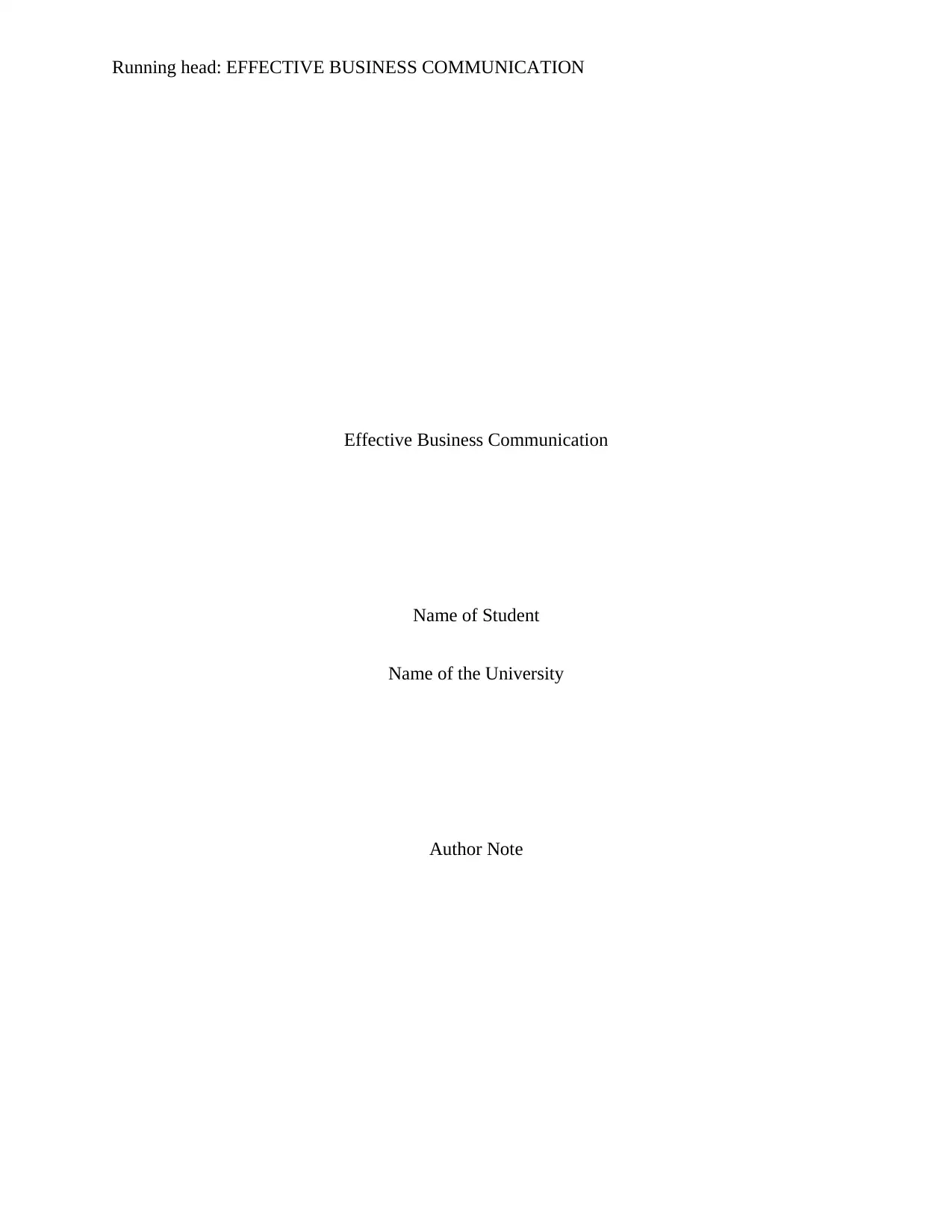
Running head: EFFECTIVE BUSINESS COMMUNICATION
Effective Business Communication
Name of Student
Name of the University
Author Note
Effective Business Communication
Name of Student
Name of the University
Author Note
Paraphrase This Document
Need a fresh take? Get an instant paraphrase of this document with our AI Paraphraser
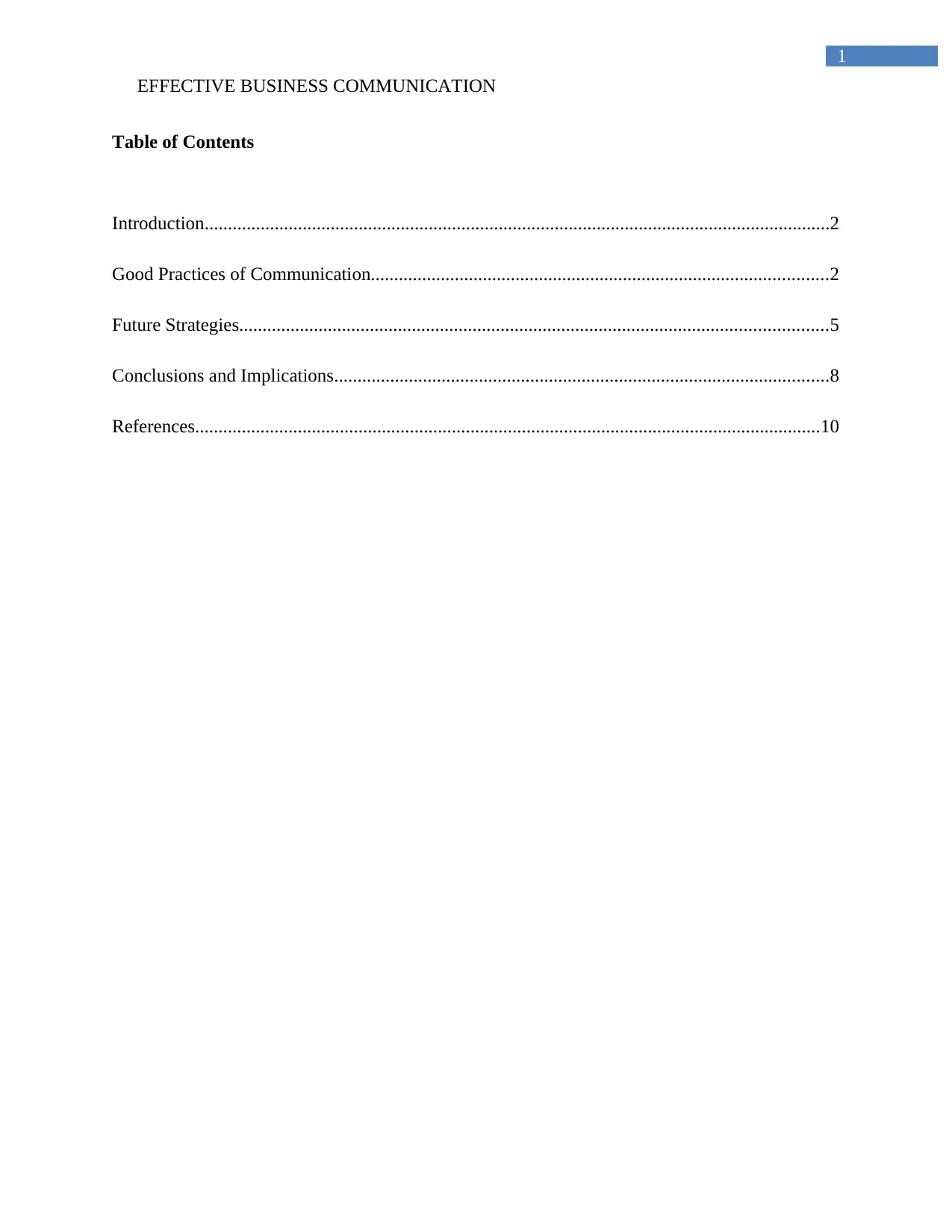
1
EFFECTIVE BUSINESS COMMUNICATION
Table of Contents
Introduction......................................................................................................................................2
Good Practices of Communication..................................................................................................2
Future Strategies..............................................................................................................................5
Conclusions and Implications..........................................................................................................8
References......................................................................................................................................10
EFFECTIVE BUSINESS COMMUNICATION
Table of Contents
Introduction......................................................................................................................................2
Good Practices of Communication..................................................................................................2
Future Strategies..............................................................................................................................5
Conclusions and Implications..........................................................................................................8
References......................................................................................................................................10
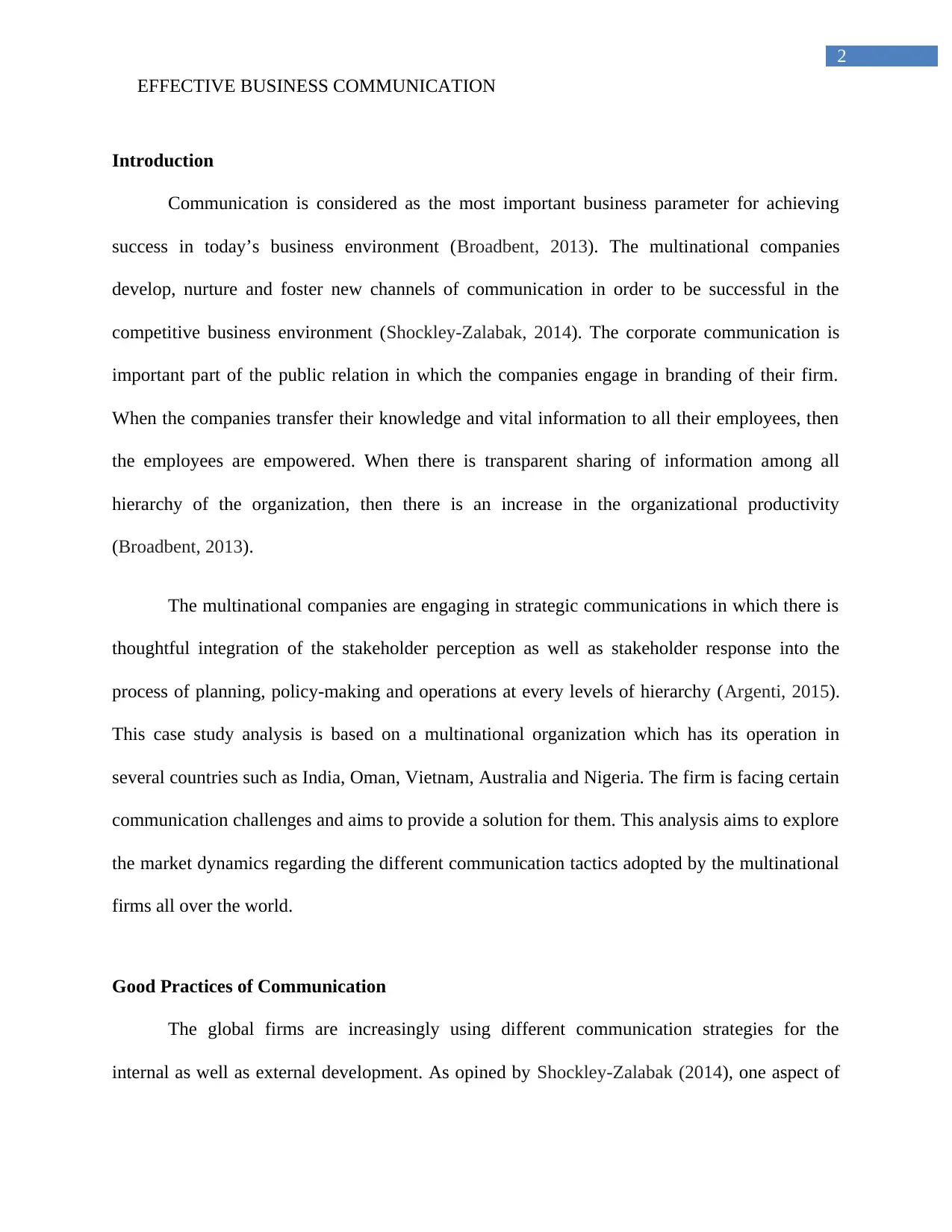
2
EFFECTIVE BUSINESS COMMUNICATION
Introduction
Communication is considered as the most important business parameter for achieving
success in today’s business environment (Broadbent, 2013). The multinational companies
develop, nurture and foster new channels of communication in order to be successful in the
competitive business environment (Shockley-Zalabak, 2014). The corporate communication is
important part of the public relation in which the companies engage in branding of their firm.
When the companies transfer their knowledge and vital information to all their employees, then
the employees are empowered. When there is transparent sharing of information among all
hierarchy of the organization, then there is an increase in the organizational productivity
(Broadbent, 2013).
The multinational companies are engaging in strategic communications in which there is
thoughtful integration of the stakeholder perception as well as stakeholder response into the
process of planning, policy-making and operations at every levels of hierarchy (Argenti, 2015).
This case study analysis is based on a multinational organization which has its operation in
several countries such as India, Oman, Vietnam, Australia and Nigeria. The firm is facing certain
communication challenges and aims to provide a solution for them. This analysis aims to explore
the market dynamics regarding the different communication tactics adopted by the multinational
firms all over the world.
Good Practices of Communication
The global firms are increasingly using different communication strategies for the
internal as well as external development. As opined by Shockley-Zalabak (2014), one aspect of
EFFECTIVE BUSINESS COMMUNICATION
Introduction
Communication is considered as the most important business parameter for achieving
success in today’s business environment (Broadbent, 2013). The multinational companies
develop, nurture and foster new channels of communication in order to be successful in the
competitive business environment (Shockley-Zalabak, 2014). The corporate communication is
important part of the public relation in which the companies engage in branding of their firm.
When the companies transfer their knowledge and vital information to all their employees, then
the employees are empowered. When there is transparent sharing of information among all
hierarchy of the organization, then there is an increase in the organizational productivity
(Broadbent, 2013).
The multinational companies are engaging in strategic communications in which there is
thoughtful integration of the stakeholder perception as well as stakeholder response into the
process of planning, policy-making and operations at every levels of hierarchy (Argenti, 2015).
This case study analysis is based on a multinational organization which has its operation in
several countries such as India, Oman, Vietnam, Australia and Nigeria. The firm is facing certain
communication challenges and aims to provide a solution for them. This analysis aims to explore
the market dynamics regarding the different communication tactics adopted by the multinational
firms all over the world.
Good Practices of Communication
The global firms are increasingly using different communication strategies for the
internal as well as external development. As opined by Shockley-Zalabak (2014), one aspect of
⊘ This is a preview!⊘
Do you want full access?
Subscribe today to unlock all pages.

Trusted by 1+ million students worldwide
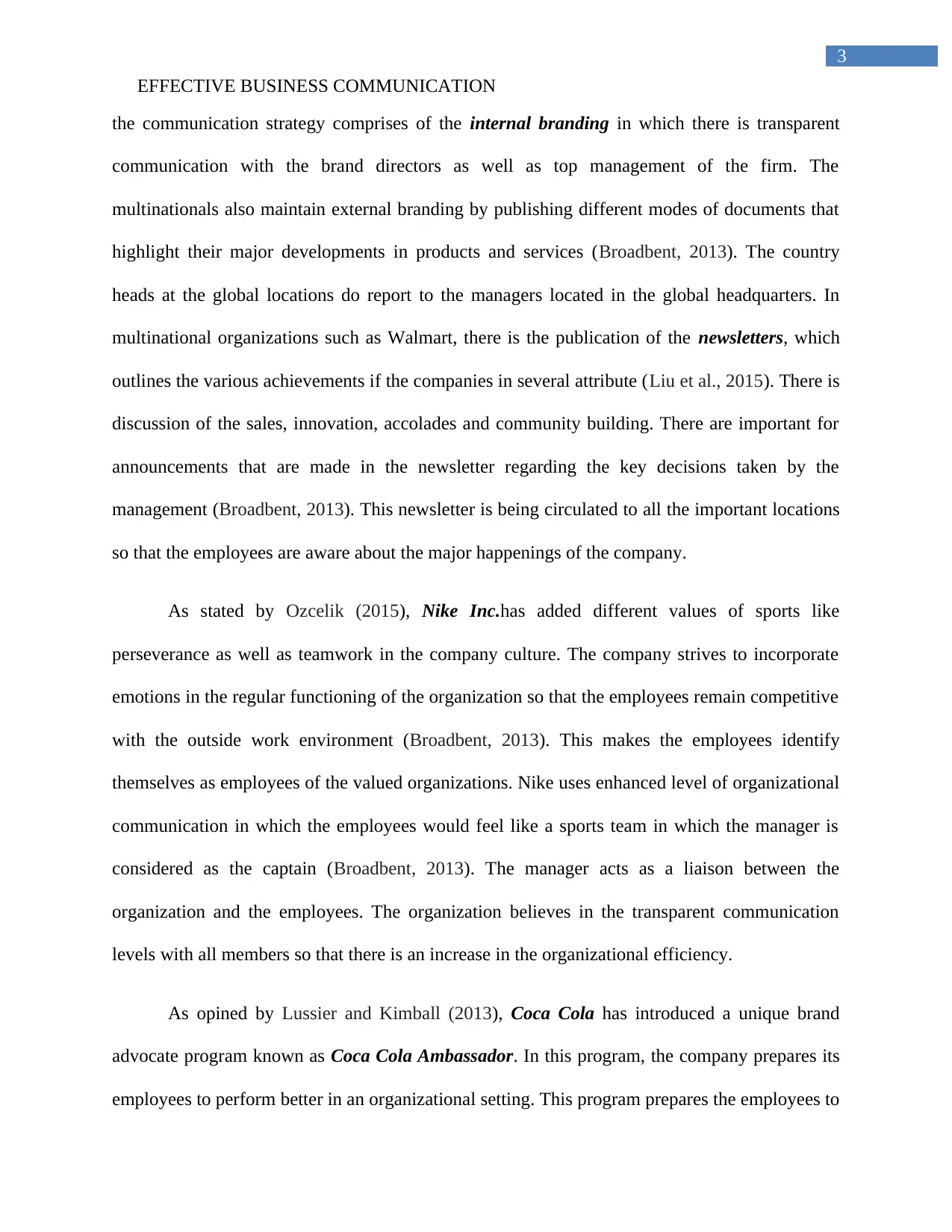
3
EFFECTIVE BUSINESS COMMUNICATION
the communication strategy comprises of the internal branding in which there is transparent
communication with the brand directors as well as top management of the firm. The
multinationals also maintain external branding by publishing different modes of documents that
highlight their major developments in products and services (Broadbent, 2013). The country
heads at the global locations do report to the managers located in the global headquarters. In
multinational organizations such as Walmart, there is the publication of the newsletters, which
outlines the various achievements if the companies in several attribute (Liu et al., 2015). There is
discussion of the sales, innovation, accolades and community building. There are important for
announcements that are made in the newsletter regarding the key decisions taken by the
management (Broadbent, 2013). This newsletter is being circulated to all the important locations
so that the employees are aware about the major happenings of the company.
As stated by Ozcelik (2015), Nike Inc.has added different values of sports like
perseverance as well as teamwork in the company culture. The company strives to incorporate
emotions in the regular functioning of the organization so that the employees remain competitive
with the outside work environment (Broadbent, 2013). This makes the employees identify
themselves as employees of the valued organizations. Nike uses enhanced level of organizational
communication in which the employees would feel like a sports team in which the manager is
considered as the captain (Broadbent, 2013). The manager acts as a liaison between the
organization and the employees. The organization believes in the transparent communication
levels with all members so that there is an increase in the organizational efficiency.
As opined by Lussier and Kimball (2013), Coca Cola has introduced a unique brand
advocate program known as Coca Cola Ambassador. In this program, the company prepares its
employees to perform better in an organizational setting. This program prepares the employees to
EFFECTIVE BUSINESS COMMUNICATION
the communication strategy comprises of the internal branding in which there is transparent
communication with the brand directors as well as top management of the firm. The
multinationals also maintain external branding by publishing different modes of documents that
highlight their major developments in products and services (Broadbent, 2013). The country
heads at the global locations do report to the managers located in the global headquarters. In
multinational organizations such as Walmart, there is the publication of the newsletters, which
outlines the various achievements if the companies in several attribute (Liu et al., 2015). There is
discussion of the sales, innovation, accolades and community building. There are important for
announcements that are made in the newsletter regarding the key decisions taken by the
management (Broadbent, 2013). This newsletter is being circulated to all the important locations
so that the employees are aware about the major happenings of the company.
As stated by Ozcelik (2015), Nike Inc.has added different values of sports like
perseverance as well as teamwork in the company culture. The company strives to incorporate
emotions in the regular functioning of the organization so that the employees remain competitive
with the outside work environment (Broadbent, 2013). This makes the employees identify
themselves as employees of the valued organizations. Nike uses enhanced level of organizational
communication in which the employees would feel like a sports team in which the manager is
considered as the captain (Broadbent, 2013). The manager acts as a liaison between the
organization and the employees. The organization believes in the transparent communication
levels with all members so that there is an increase in the organizational efficiency.
As opined by Lussier and Kimball (2013), Coca Cola has introduced a unique brand
advocate program known as Coca Cola Ambassador. In this program, the company prepares its
employees to perform better in an organizational setting. This program prepares the employees to
Paraphrase This Document
Need a fresh take? Get an instant paraphrase of this document with our AI Paraphraser
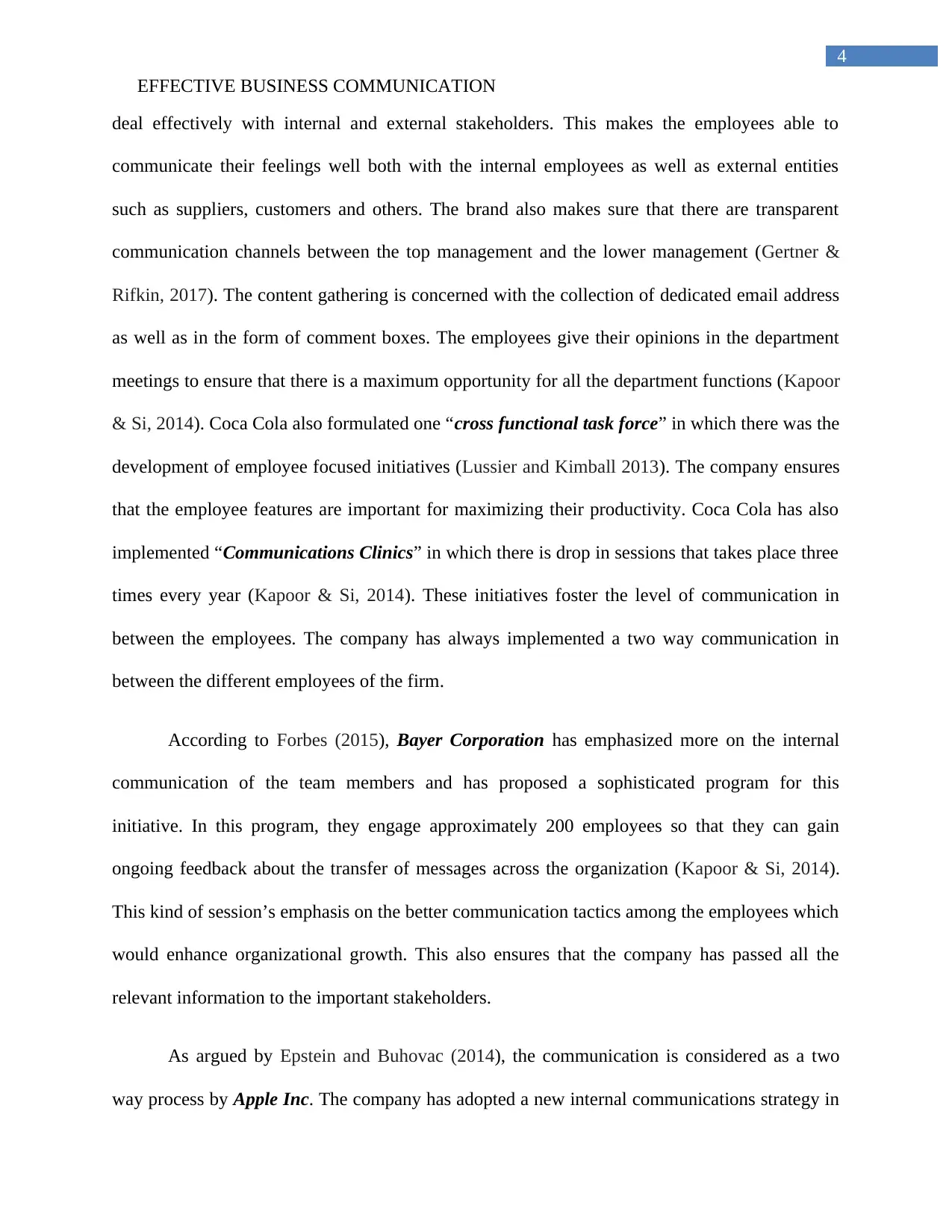
4
EFFECTIVE BUSINESS COMMUNICATION
deal effectively with internal and external stakeholders. This makes the employees able to
communicate their feelings well both with the internal employees as well as external entities
such as suppliers, customers and others. The brand also makes sure that there are transparent
communication channels between the top management and the lower management (Gertner &
Rifkin, 2017). The content gathering is concerned with the collection of dedicated email address
as well as in the form of comment boxes. The employees give their opinions in the department
meetings to ensure that there is a maximum opportunity for all the department functions (Kapoor
& Si, 2014). Coca Cola also formulated one “cross functional task force” in which there was the
development of employee focused initiatives (Lussier and Kimball 2013). The company ensures
that the employee features are important for maximizing their productivity. Coca Cola has also
implemented “Communications Clinics” in which there is drop in sessions that takes place three
times every year (Kapoor & Si, 2014). These initiatives foster the level of communication in
between the employees. The company has always implemented a two way communication in
between the different employees of the firm.
According to Forbes (2015), Bayer Corporation has emphasized more on the internal
communication of the team members and has proposed a sophisticated program for this
initiative. In this program, they engage approximately 200 employees so that they can gain
ongoing feedback about the transfer of messages across the organization (Kapoor & Si, 2014).
This kind of session’s emphasis on the better communication tactics among the employees which
would enhance organizational growth. This also ensures that the company has passed all the
relevant information to the important stakeholders.
As argued by Epstein and Buhovac (2014), the communication is considered as a two
way process by Apple Inc. The company has adopted a new internal communications strategy in
EFFECTIVE BUSINESS COMMUNICATION
deal effectively with internal and external stakeholders. This makes the employees able to
communicate their feelings well both with the internal employees as well as external entities
such as suppliers, customers and others. The brand also makes sure that there are transparent
communication channels between the top management and the lower management (Gertner &
Rifkin, 2017). The content gathering is concerned with the collection of dedicated email address
as well as in the form of comment boxes. The employees give their opinions in the department
meetings to ensure that there is a maximum opportunity for all the department functions (Kapoor
& Si, 2014). Coca Cola also formulated one “cross functional task force” in which there was the
development of employee focused initiatives (Lussier and Kimball 2013). The company ensures
that the employee features are important for maximizing their productivity. Coca Cola has also
implemented “Communications Clinics” in which there is drop in sessions that takes place three
times every year (Kapoor & Si, 2014). These initiatives foster the level of communication in
between the employees. The company has always implemented a two way communication in
between the different employees of the firm.
According to Forbes (2015), Bayer Corporation has emphasized more on the internal
communication of the team members and has proposed a sophisticated program for this
initiative. In this program, they engage approximately 200 employees so that they can gain
ongoing feedback about the transfer of messages across the organization (Kapoor & Si, 2014).
This kind of session’s emphasis on the better communication tactics among the employees which
would enhance organizational growth. This also ensures that the company has passed all the
relevant information to the important stakeholders.
As argued by Epstein and Buhovac (2014), the communication is considered as a two
way process by Apple Inc. The company has adopted a new internal communications strategy in
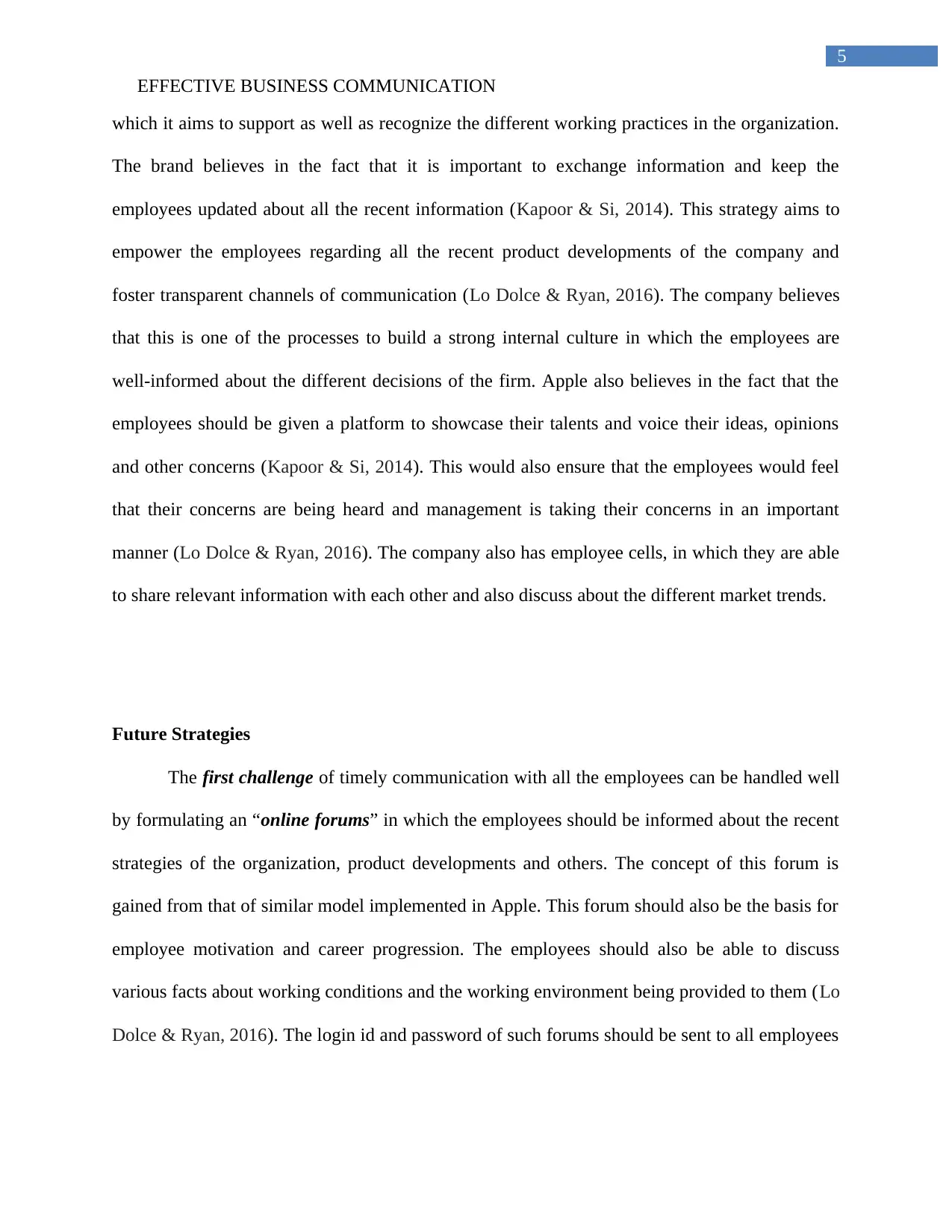
5
EFFECTIVE BUSINESS COMMUNICATION
which it aims to support as well as recognize the different working practices in the organization.
The brand believes in the fact that it is important to exchange information and keep the
employees updated about all the recent information (Kapoor & Si, 2014). This strategy aims to
empower the employees regarding all the recent product developments of the company and
foster transparent channels of communication (Lo Dolce & Ryan, 2016). The company believes
that this is one of the processes to build a strong internal culture in which the employees are
well-informed about the different decisions of the firm. Apple also believes in the fact that the
employees should be given a platform to showcase their talents and voice their ideas, opinions
and other concerns (Kapoor & Si, 2014). This would also ensure that the employees would feel
that their concerns are being heard and management is taking their concerns in an important
manner (Lo Dolce & Ryan, 2016). The company also has employee cells, in which they are able
to share relevant information with each other and also discuss about the different market trends.
Future Strategies
The first challenge of timely communication with all the employees can be handled well
by formulating an “online forums” in which the employees should be informed about the recent
strategies of the organization, product developments and others. The concept of this forum is
gained from that of similar model implemented in Apple. This forum should also be the basis for
employee motivation and career progression. The employees should also be able to discuss
various facts about working conditions and the working environment being provided to them (Lo
Dolce & Ryan, 2016). The login id and password of such forums should be sent to all employees
EFFECTIVE BUSINESS COMMUNICATION
which it aims to support as well as recognize the different working practices in the organization.
The brand believes in the fact that it is important to exchange information and keep the
employees updated about all the recent information (Kapoor & Si, 2014). This strategy aims to
empower the employees regarding all the recent product developments of the company and
foster transparent channels of communication (Lo Dolce & Ryan, 2016). The company believes
that this is one of the processes to build a strong internal culture in which the employees are
well-informed about the different decisions of the firm. Apple also believes in the fact that the
employees should be given a platform to showcase their talents and voice their ideas, opinions
and other concerns (Kapoor & Si, 2014). This would also ensure that the employees would feel
that their concerns are being heard and management is taking their concerns in an important
manner (Lo Dolce & Ryan, 2016). The company also has employee cells, in which they are able
to share relevant information with each other and also discuss about the different market trends.
Future Strategies
The first challenge of timely communication with all the employees can be handled well
by formulating an “online forums” in which the employees should be informed about the recent
strategies of the organization, product developments and others. The concept of this forum is
gained from that of similar model implemented in Apple. This forum should also be the basis for
employee motivation and career progression. The employees should also be able to discuss
various facts about working conditions and the working environment being provided to them (Lo
Dolce & Ryan, 2016). The login id and password of such forums should be sent to all employees
⊘ This is a preview!⊘
Do you want full access?
Subscribe today to unlock all pages.

Trusted by 1+ million students worldwide
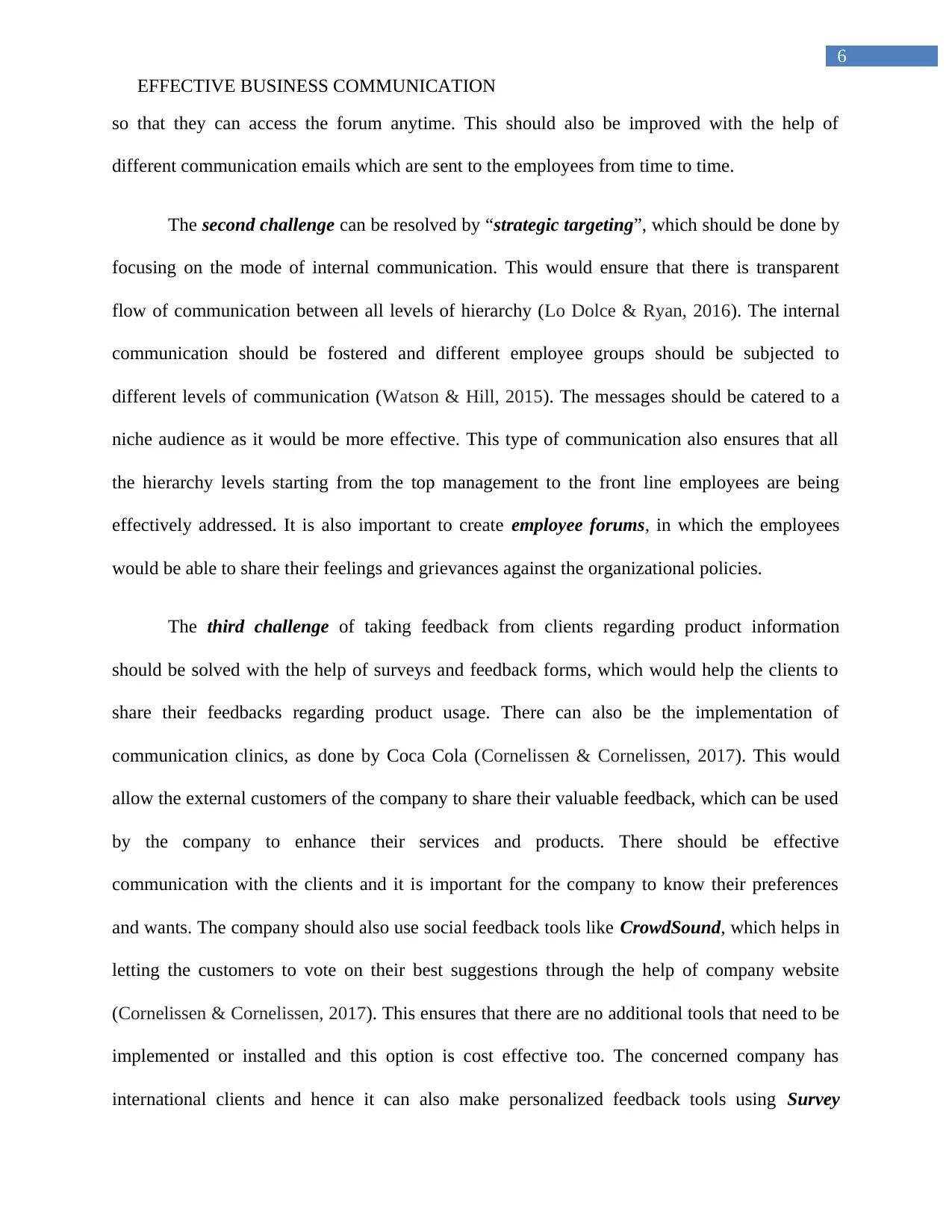
6
EFFECTIVE BUSINESS COMMUNICATION
so that they can access the forum anytime. This should also be improved with the help of
different communication emails which are sent to the employees from time to time.
The second challenge can be resolved by “strategic targeting”, which should be done by
focusing on the mode of internal communication. This would ensure that there is transparent
flow of communication between all levels of hierarchy (Lo Dolce & Ryan, 2016). The internal
communication should be fostered and different employee groups should be subjected to
different levels of communication (Watson & Hill, 2015). The messages should be catered to a
niche audience as it would be more effective. This type of communication also ensures that all
the hierarchy levels starting from the top management to the front line employees are being
effectively addressed. It is also important to create employee forums, in which the employees
would be able to share their feelings and grievances against the organizational policies.
The third challenge of taking feedback from clients regarding product information
should be solved with the help of surveys and feedback forms, which would help the clients to
share their feedbacks regarding product usage. There can also be the implementation of
communication clinics, as done by Coca Cola (Cornelissen & Cornelissen, 2017). This would
allow the external customers of the company to share their valuable feedback, which can be used
by the company to enhance their services and products. There should be effective
communication with the clients and it is important for the company to know their preferences
and wants. The company should also use social feedback tools like CrowdSound, which helps in
letting the customers to vote on their best suggestions through the help of company website
(Cornelissen & Cornelissen, 2017). This ensures that there are no additional tools that need to be
implemented or installed and this option is cost effective too. The concerned company has
international clients and hence it can also make personalized feedback tools using Survey
EFFECTIVE BUSINESS COMMUNICATION
so that they can access the forum anytime. This should also be improved with the help of
different communication emails which are sent to the employees from time to time.
The second challenge can be resolved by “strategic targeting”, which should be done by
focusing on the mode of internal communication. This would ensure that there is transparent
flow of communication between all levels of hierarchy (Lo Dolce & Ryan, 2016). The internal
communication should be fostered and different employee groups should be subjected to
different levels of communication (Watson & Hill, 2015). The messages should be catered to a
niche audience as it would be more effective. This type of communication also ensures that all
the hierarchy levels starting from the top management to the front line employees are being
effectively addressed. It is also important to create employee forums, in which the employees
would be able to share their feelings and grievances against the organizational policies.
The third challenge of taking feedback from clients regarding product information
should be solved with the help of surveys and feedback forms, which would help the clients to
share their feedbacks regarding product usage. There can also be the implementation of
communication clinics, as done by Coca Cola (Cornelissen & Cornelissen, 2017). This would
allow the external customers of the company to share their valuable feedback, which can be used
by the company to enhance their services and products. There should be effective
communication with the clients and it is important for the company to know their preferences
and wants. The company should also use social feedback tools like CrowdSound, which helps in
letting the customers to vote on their best suggestions through the help of company website
(Cornelissen & Cornelissen, 2017). This ensures that there are no additional tools that need to be
implemented or installed and this option is cost effective too. The concerned company has
international clients and hence it can also make personalized feedback tools using Survey
Paraphrase This Document
Need a fresh take? Get an instant paraphrase of this document with our AI Paraphraser
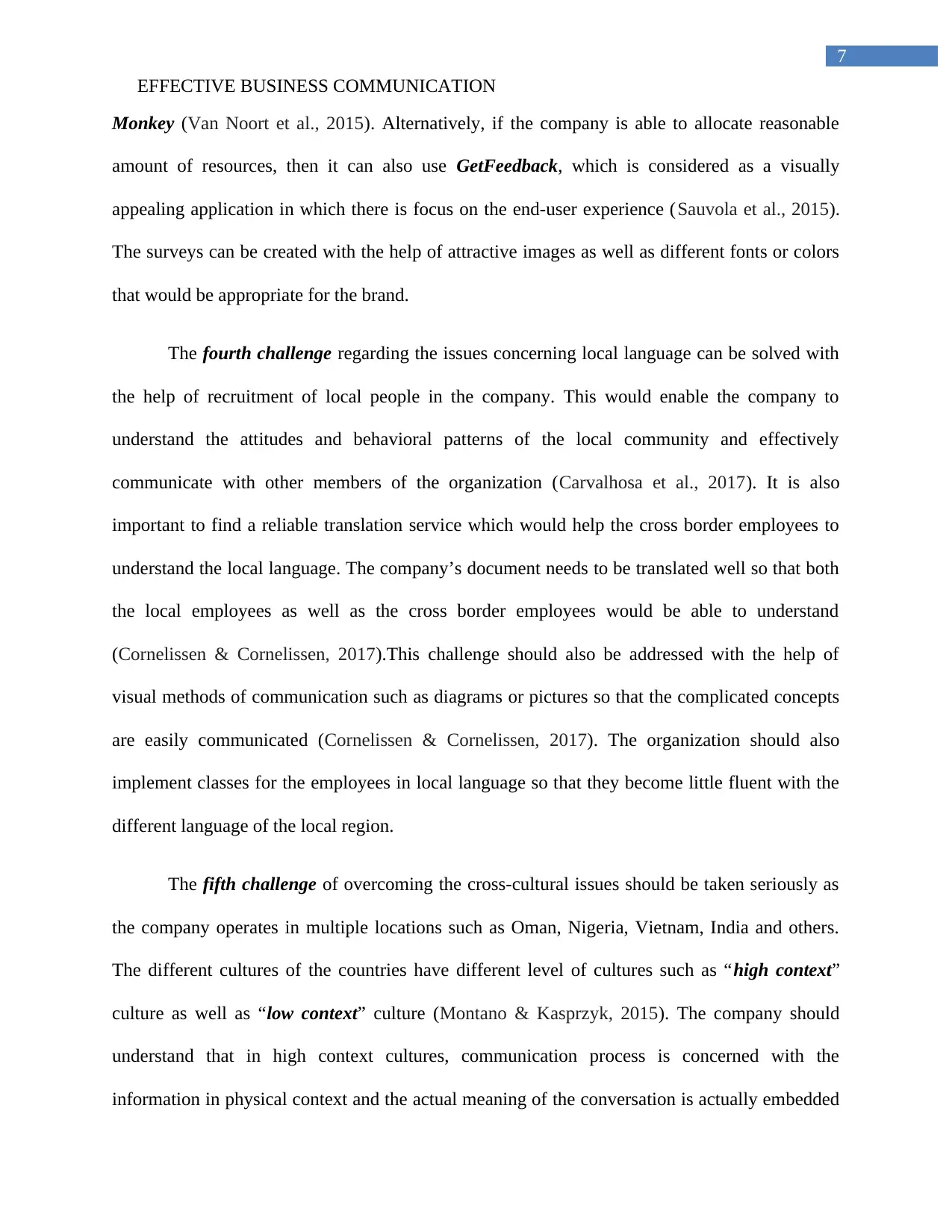
7
EFFECTIVE BUSINESS COMMUNICATION
Monkey (Van Noort et al., 2015). Alternatively, if the company is able to allocate reasonable
amount of resources, then it can also use GetFeedback, which is considered as a visually
appealing application in which there is focus on the end-user experience (Sauvola et al., 2015).
The surveys can be created with the help of attractive images as well as different fonts or colors
that would be appropriate for the brand.
The fourth challenge regarding the issues concerning local language can be solved with
the help of recruitment of local people in the company. This would enable the company to
understand the attitudes and behavioral patterns of the local community and effectively
communicate with other members of the organization (Carvalhosa et al., 2017). It is also
important to find a reliable translation service which would help the cross border employees to
understand the local language. The company’s document needs to be translated well so that both
the local employees as well as the cross border employees would be able to understand
(Cornelissen & Cornelissen, 2017).This challenge should also be addressed with the help of
visual methods of communication such as diagrams or pictures so that the complicated concepts
are easily communicated (Cornelissen & Cornelissen, 2017). The organization should also
implement classes for the employees in local language so that they become little fluent with the
different language of the local region.
The fifth challenge of overcoming the cross-cultural issues should be taken seriously as
the company operates in multiple locations such as Oman, Nigeria, Vietnam, India and others.
The different cultures of the countries have different level of cultures such as “high context”
culture as well as “low context” culture (Montano & Kasprzyk, 2015). The company should
understand that in high context cultures, communication process is concerned with the
information in physical context and the actual meaning of the conversation is actually embedded
EFFECTIVE BUSINESS COMMUNICATION
Monkey (Van Noort et al., 2015). Alternatively, if the company is able to allocate reasonable
amount of resources, then it can also use GetFeedback, which is considered as a visually
appealing application in which there is focus on the end-user experience (Sauvola et al., 2015).
The surveys can be created with the help of attractive images as well as different fonts or colors
that would be appropriate for the brand.
The fourth challenge regarding the issues concerning local language can be solved with
the help of recruitment of local people in the company. This would enable the company to
understand the attitudes and behavioral patterns of the local community and effectively
communicate with other members of the organization (Carvalhosa et al., 2017). It is also
important to find a reliable translation service which would help the cross border employees to
understand the local language. The company’s document needs to be translated well so that both
the local employees as well as the cross border employees would be able to understand
(Cornelissen & Cornelissen, 2017).This challenge should also be addressed with the help of
visual methods of communication such as diagrams or pictures so that the complicated concepts
are easily communicated (Cornelissen & Cornelissen, 2017). The organization should also
implement classes for the employees in local language so that they become little fluent with the
different language of the local region.
The fifth challenge of overcoming the cross-cultural issues should be taken seriously as
the company operates in multiple locations such as Oman, Nigeria, Vietnam, India and others.
The different cultures of the countries have different level of cultures such as “high context”
culture as well as “low context” culture (Montano & Kasprzyk, 2015). The company should
understand that in high context cultures, communication process is concerned with the
information in physical context and the actual meaning of the conversation is actually embedded
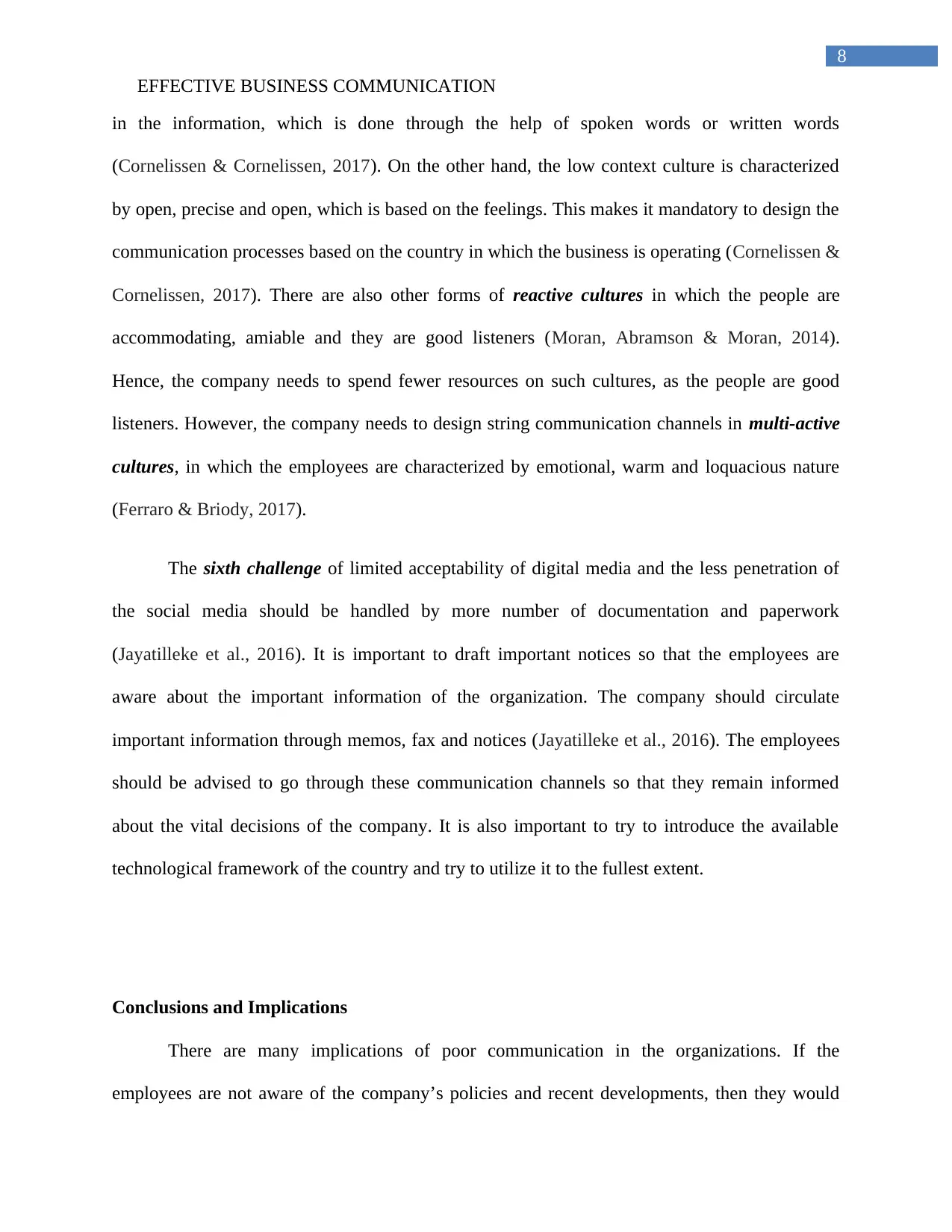
8
EFFECTIVE BUSINESS COMMUNICATION
in the information, which is done through the help of spoken words or written words
(Cornelissen & Cornelissen, 2017). On the other hand, the low context culture is characterized
by open, precise and open, which is based on the feelings. This makes it mandatory to design the
communication processes based on the country in which the business is operating (Cornelissen &
Cornelissen, 2017). There are also other forms of reactive cultures in which the people are
accommodating, amiable and they are good listeners (Moran, Abramson & Moran, 2014).
Hence, the company needs to spend fewer resources on such cultures, as the people are good
listeners. However, the company needs to design string communication channels in multi-active
cultures, in which the employees are characterized by emotional, warm and loquacious nature
(Ferraro & Briody, 2017).
The sixth challenge of limited acceptability of digital media and the less penetration of
the social media should be handled by more number of documentation and paperwork
(Jayatilleke et al., 2016). It is important to draft important notices so that the employees are
aware about the important information of the organization. The company should circulate
important information through memos, fax and notices (Jayatilleke et al., 2016). The employees
should be advised to go through these communication channels so that they remain informed
about the vital decisions of the company. It is also important to try to introduce the available
technological framework of the country and try to utilize it to the fullest extent.
Conclusions and Implications
There are many implications of poor communication in the organizations. If the
employees are not aware of the company’s policies and recent developments, then they would
EFFECTIVE BUSINESS COMMUNICATION
in the information, which is done through the help of spoken words or written words
(Cornelissen & Cornelissen, 2017). On the other hand, the low context culture is characterized
by open, precise and open, which is based on the feelings. This makes it mandatory to design the
communication processes based on the country in which the business is operating (Cornelissen &
Cornelissen, 2017). There are also other forms of reactive cultures in which the people are
accommodating, amiable and they are good listeners (Moran, Abramson & Moran, 2014).
Hence, the company needs to spend fewer resources on such cultures, as the people are good
listeners. However, the company needs to design string communication channels in multi-active
cultures, in which the employees are characterized by emotional, warm and loquacious nature
(Ferraro & Briody, 2017).
The sixth challenge of limited acceptability of digital media and the less penetration of
the social media should be handled by more number of documentation and paperwork
(Jayatilleke et al., 2016). It is important to draft important notices so that the employees are
aware about the important information of the organization. The company should circulate
important information through memos, fax and notices (Jayatilleke et al., 2016). The employees
should be advised to go through these communication channels so that they remain informed
about the vital decisions of the company. It is also important to try to introduce the available
technological framework of the country and try to utilize it to the fullest extent.
Conclusions and Implications
There are many implications of poor communication in the organizations. If the
employees are not aware of the company’s policies and recent developments, then they would
⊘ This is a preview!⊘
Do you want full access?
Subscribe today to unlock all pages.

Trusted by 1+ million students worldwide
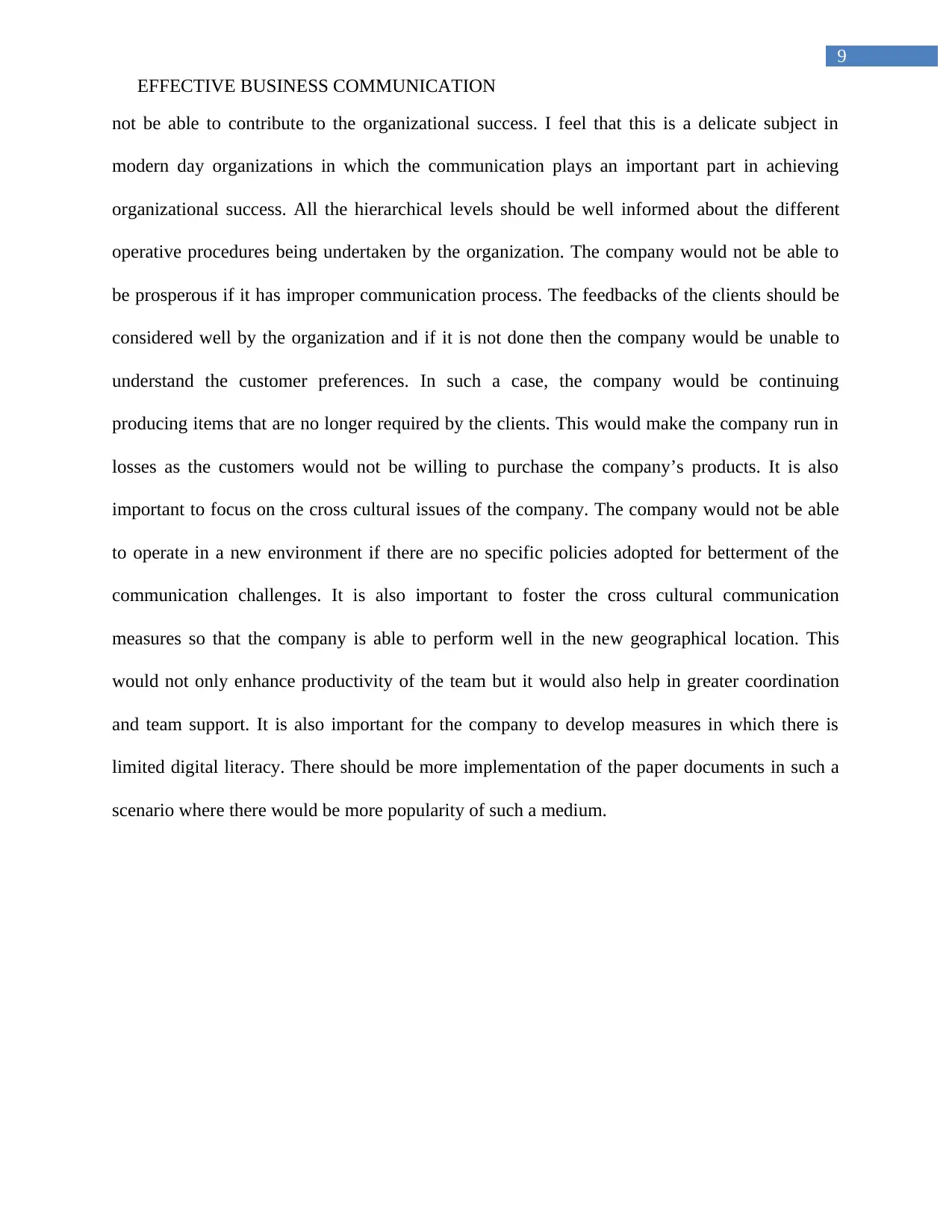
9
EFFECTIVE BUSINESS COMMUNICATION
not be able to contribute to the organizational success. I feel that this is a delicate subject in
modern day organizations in which the communication plays an important part in achieving
organizational success. All the hierarchical levels should be well informed about the different
operative procedures being undertaken by the organization. The company would not be able to
be prosperous if it has improper communication process. The feedbacks of the clients should be
considered well by the organization and if it is not done then the company would be unable to
understand the customer preferences. In such a case, the company would be continuing
producing items that are no longer required by the clients. This would make the company run in
losses as the customers would not be willing to purchase the company’s products. It is also
important to focus on the cross cultural issues of the company. The company would not be able
to operate in a new environment if there are no specific policies adopted for betterment of the
communication challenges. It is also important to foster the cross cultural communication
measures so that the company is able to perform well in the new geographical location. This
would not only enhance productivity of the team but it would also help in greater coordination
and team support. It is also important for the company to develop measures in which there is
limited digital literacy. There should be more implementation of the paper documents in such a
scenario where there would be more popularity of such a medium.
EFFECTIVE BUSINESS COMMUNICATION
not be able to contribute to the organizational success. I feel that this is a delicate subject in
modern day organizations in which the communication plays an important part in achieving
organizational success. All the hierarchical levels should be well informed about the different
operative procedures being undertaken by the organization. The company would not be able to
be prosperous if it has improper communication process. The feedbacks of the clients should be
considered well by the organization and if it is not done then the company would be unable to
understand the customer preferences. In such a case, the company would be continuing
producing items that are no longer required by the clients. This would make the company run in
losses as the customers would not be willing to purchase the company’s products. It is also
important to focus on the cross cultural issues of the company. The company would not be able
to operate in a new environment if there are no specific policies adopted for betterment of the
communication challenges. It is also important to foster the cross cultural communication
measures so that the company is able to perform well in the new geographical location. This
would not only enhance productivity of the team but it would also help in greater coordination
and team support. It is also important for the company to develop measures in which there is
limited digital literacy. There should be more implementation of the paper documents in such a
scenario where there would be more popularity of such a medium.
Paraphrase This Document
Need a fresh take? Get an instant paraphrase of this document with our AI Paraphraser
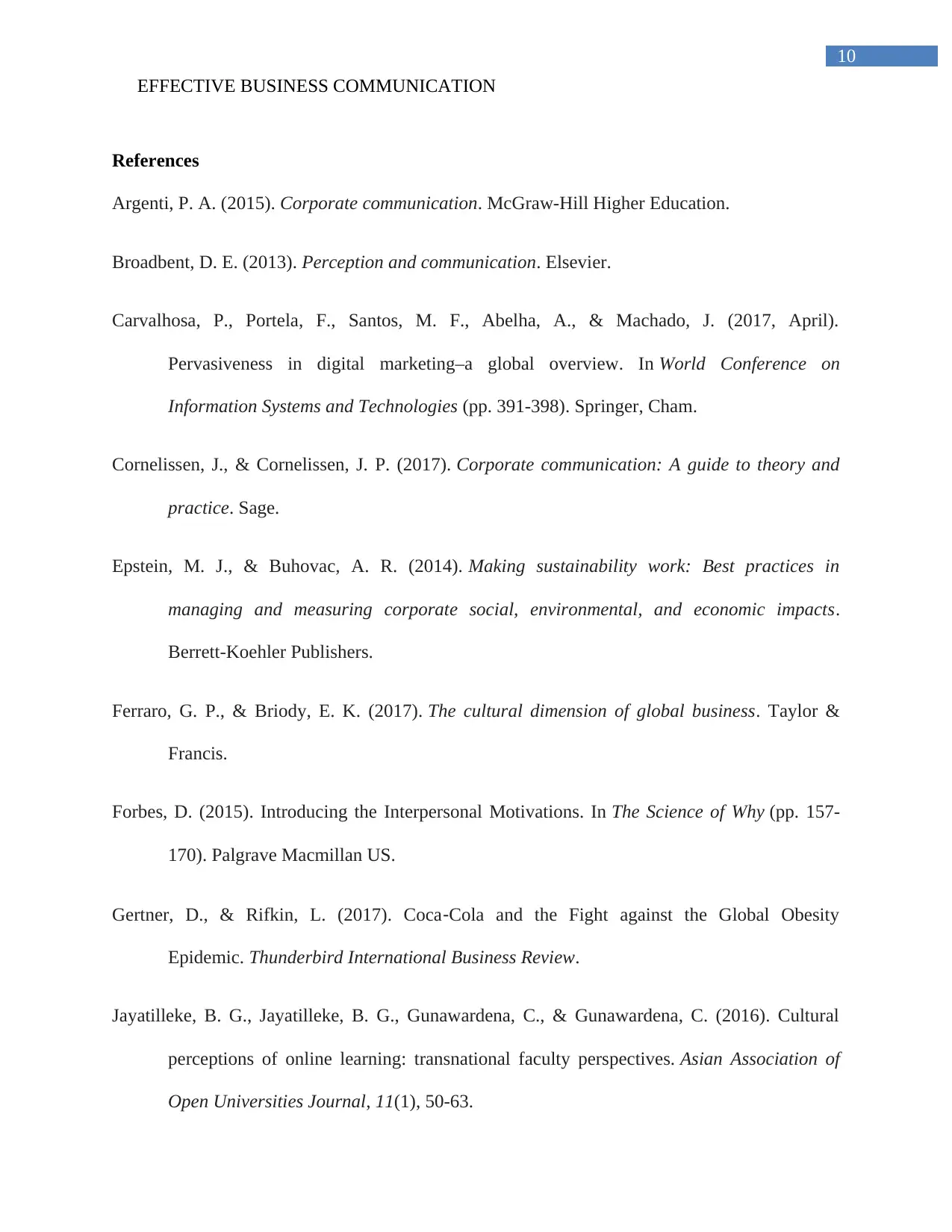
10
EFFECTIVE BUSINESS COMMUNICATION
References
Argenti, P. A. (2015). Corporate communication. McGraw-Hill Higher Education.
Broadbent, D. E. (2013). Perception and communication. Elsevier.
Carvalhosa, P., Portela, F., Santos, M. F., Abelha, A., & Machado, J. (2017, April).
Pervasiveness in digital marketing–a global overview. In World Conference on
Information Systems and Technologies (pp. 391-398). Springer, Cham.
Cornelissen, J., & Cornelissen, J. P. (2017). Corporate communication: A guide to theory and
practice. Sage.
Epstein, M. J., & Buhovac, A. R. (2014). Making sustainability work: Best practices in
managing and measuring corporate social, environmental, and economic impacts.
Berrett-Koehler Publishers.
Ferraro, G. P., & Briody, E. K. (2017). The cultural dimension of global business. Taylor &
Francis.
Forbes, D. (2015). Introducing the Interpersonal Motivations. In The Science of Why (pp. 157-
170). Palgrave Macmillan US.
Gertner, D., & Rifkin, L. (2017). Coca‐Cola and the Fight against the Global Obesity
Epidemic. Thunderbird International Business Review.
Jayatilleke, B. G., Jayatilleke, B. G., Gunawardena, C., & Gunawardena, C. (2016). Cultural
perceptions of online learning: transnational faculty perspectives. Asian Association of
Open Universities Journal, 11(1), 50-63.
EFFECTIVE BUSINESS COMMUNICATION
References
Argenti, P. A. (2015). Corporate communication. McGraw-Hill Higher Education.
Broadbent, D. E. (2013). Perception and communication. Elsevier.
Carvalhosa, P., Portela, F., Santos, M. F., Abelha, A., & Machado, J. (2017, April).
Pervasiveness in digital marketing–a global overview. In World Conference on
Information Systems and Technologies (pp. 391-398). Springer, Cham.
Cornelissen, J., & Cornelissen, J. P. (2017). Corporate communication: A guide to theory and
practice. Sage.
Epstein, M. J., & Buhovac, A. R. (2014). Making sustainability work: Best practices in
managing and measuring corporate social, environmental, and economic impacts.
Berrett-Koehler Publishers.
Ferraro, G. P., & Briody, E. K. (2017). The cultural dimension of global business. Taylor &
Francis.
Forbes, D. (2015). Introducing the Interpersonal Motivations. In The Science of Why (pp. 157-
170). Palgrave Macmillan US.
Gertner, D., & Rifkin, L. (2017). Coca‐Cola and the Fight against the Global Obesity
Epidemic. Thunderbird International Business Review.
Jayatilleke, B. G., Jayatilleke, B. G., Gunawardena, C., & Gunawardena, C. (2016). Cultural
perceptions of online learning: transnational faculty perspectives. Asian Association of
Open Universities Journal, 11(1), 50-63.
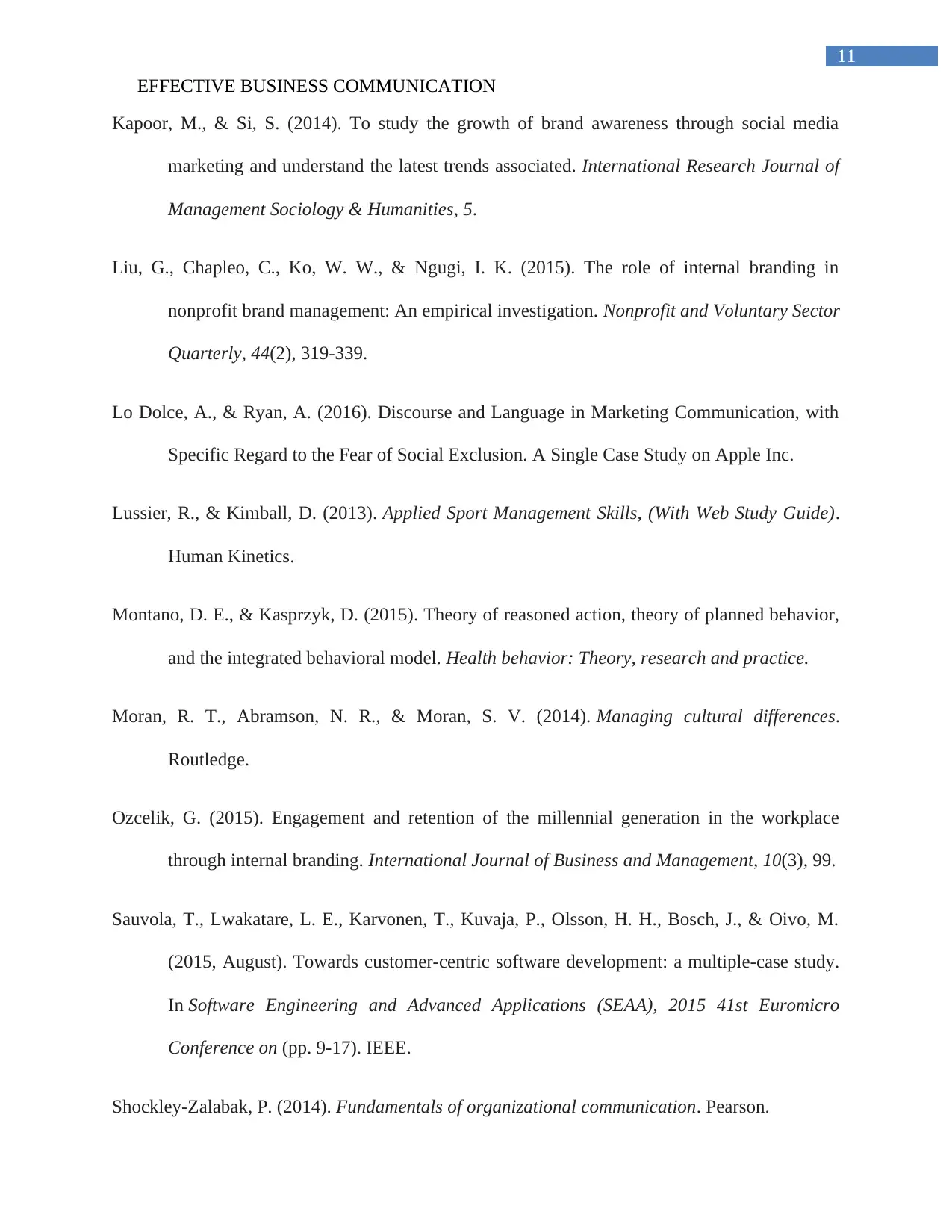
11
EFFECTIVE BUSINESS COMMUNICATION
Kapoor, M., & Si, S. (2014). To study the growth of brand awareness through social media
marketing and understand the latest trends associated. International Research Journal of
Management Sociology & Humanities, 5.
Liu, G., Chapleo, C., Ko, W. W., & Ngugi, I. K. (2015). The role of internal branding in
nonprofit brand management: An empirical investigation. Nonprofit and Voluntary Sector
Quarterly, 44(2), 319-339.
Lo Dolce, A., & Ryan, A. (2016). Discourse and Language in Marketing Communication, with
Specific Regard to the Fear of Social Exclusion. A Single Case Study on Apple Inc.
Lussier, R., & Kimball, D. (2013). Applied Sport Management Skills, (With Web Study Guide).
Human Kinetics.
Montano, D. E., & Kasprzyk, D. (2015). Theory of reasoned action, theory of planned behavior,
and the integrated behavioral model. Health behavior: Theory, research and practice.
Moran, R. T., Abramson, N. R., & Moran, S. V. (2014). Managing cultural differences.
Routledge.
Ozcelik, G. (2015). Engagement and retention of the millennial generation in the workplace
through internal branding. International Journal of Business and Management, 10(3), 99.
Sauvola, T., Lwakatare, L. E., Karvonen, T., Kuvaja, P., Olsson, H. H., Bosch, J., & Oivo, M.
(2015, August). Towards customer-centric software development: a multiple-case study.
In Software Engineering and Advanced Applications (SEAA), 2015 41st Euromicro
Conference on (pp. 9-17). IEEE.
Shockley-Zalabak, P. (2014). Fundamentals of organizational communication. Pearson.
EFFECTIVE BUSINESS COMMUNICATION
Kapoor, M., & Si, S. (2014). To study the growth of brand awareness through social media
marketing and understand the latest trends associated. International Research Journal of
Management Sociology & Humanities, 5.
Liu, G., Chapleo, C., Ko, W. W., & Ngugi, I. K. (2015). The role of internal branding in
nonprofit brand management: An empirical investigation. Nonprofit and Voluntary Sector
Quarterly, 44(2), 319-339.
Lo Dolce, A., & Ryan, A. (2016). Discourse and Language in Marketing Communication, with
Specific Regard to the Fear of Social Exclusion. A Single Case Study on Apple Inc.
Lussier, R., & Kimball, D. (2013). Applied Sport Management Skills, (With Web Study Guide).
Human Kinetics.
Montano, D. E., & Kasprzyk, D. (2015). Theory of reasoned action, theory of planned behavior,
and the integrated behavioral model. Health behavior: Theory, research and practice.
Moran, R. T., Abramson, N. R., & Moran, S. V. (2014). Managing cultural differences.
Routledge.
Ozcelik, G. (2015). Engagement and retention of the millennial generation in the workplace
through internal branding. International Journal of Business and Management, 10(3), 99.
Sauvola, T., Lwakatare, L. E., Karvonen, T., Kuvaja, P., Olsson, H. H., Bosch, J., & Oivo, M.
(2015, August). Towards customer-centric software development: a multiple-case study.
In Software Engineering and Advanced Applications (SEAA), 2015 41st Euromicro
Conference on (pp. 9-17). IEEE.
Shockley-Zalabak, P. (2014). Fundamentals of organizational communication. Pearson.
⊘ This is a preview!⊘
Do you want full access?
Subscribe today to unlock all pages.

Trusted by 1+ million students worldwide
1 out of 13
Related Documents
Your All-in-One AI-Powered Toolkit for Academic Success.
+13062052269
info@desklib.com
Available 24*7 on WhatsApp / Email
![[object Object]](/_next/static/media/star-bottom.7253800d.svg)
Unlock your academic potential
Copyright © 2020–2025 A2Z Services. All Rights Reserved. Developed and managed by ZUCOL.




